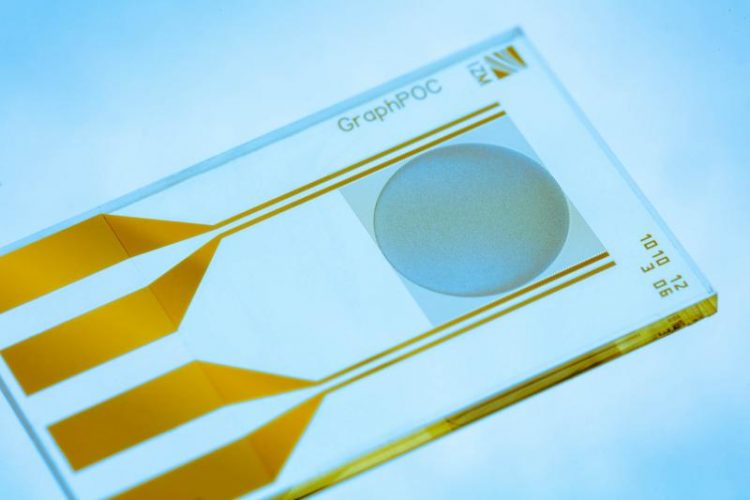Certainty in just 15 minutes – researchers develop a graphene oxid based rapid test to detect infections

Fraunhofer researchers are developing graphene oxid based biosensors to detect bacterial andviral infections within just 15 minutes. © Fraunhofer IZM / Volker Mai
The current situation with the COVID 19 pandemic underscores the importance of detecting infections quickly and accurately to prevent further spread. Today, symptoms provide the clues that help diagnose viral or bacterial infections.
However, many infections have similar symptoms, so these signs can easily be misread and the disease misdiagnosed. Blood tests provide certainty, but laboratories only carry these out when prescribed by the family physician.
By the time the results arrive from the lab, doctors have often prescribed an antibiotic that may well be unnecessary.
Just one drop of blood for a diagnosis
Researchers at the Fraunhofer IZM in Berlin have been working on the project Graph-POC since April 2018 on a graphene oxid based sensor platform to rise to precisely these challenges in diagnosing infections.
A single drop of blood or saliva is all it takes to perform an accurate analysis. Just a few minutes after the drop is applied to the sensor’s surface, electrical signals convey the test result to the family doctor’s office.
This rapid test provides certainty within just 15 minutes to replace the protracted blood work in the lab. It takes the error and guesswork out of diagnosis so the physician can prescribe the appropriate treatment or suitable antibiotics.
The test may also be set up to detect antibodies that are present after a patient has recovered from an infection. Fraunhofer IZM researchers are now focusing on this application to detect earlier infections with the COVID-19 virus, which can help with efforts to trace how the infection has spread.
The human body forms molecules or proteins called biomarkers in response to an infection. Capture molecules placed on the surface of the graphene-based sensor to detect these biomarkers.
These tiny molecules contain just a few atoms, so the sensor has to be extremely accurate. Differential measurements of biomarkers’ concentration determine if an infection is present.
3D structure to enlarge the measuring surface
This sensor platform’s most remarkable feature is its base material: Electrically conductive and biocompatible, graphene oxid is also a very reliable means of detection.
To date, it has only been used in microelectronics in its original form, a 2D monolayer. Fraunhofer IZM researchers are now applying it in a 3D structure in form of flakes. This 3D form increases the measuring surface and the accuracy of measurements.
Manuel Bäuscher, scientist at Fraunhofer IZM and sub-project manager at Graph-POC, sees great prospects ahead for these graphene oxid sensors: “We can pivot from the current medical field to also develop in the direction of the point of need; that is, towards environmental technology and the detection of environmental impacts. But of course the corona application is our first priority.”
The graphene oxids flakes’ 3D array and heightened sensitivity also open the door to further applications. For example, it could detect harmful gases such as carbon monoxide or acetone even at room temperature. As it stands, these gases have to first be heated to trigger a surface reaction that today’s sensors can detect. The graphene oxid sensor reacts at lower temperatures when metal oxides bond with its sensitive surface.
Fraunhofer IZM researchers are taking on another challenge to scale the production process up for mass manufacturing: They are looking to apply the graphene oxid coating at the wafer level so that hundreds of chips can be processed at once.
Antibodies detectable after coronavirus infections in about one year
The graphene oxid based sensors have to be integrated into a plastic carrier and the reliability of the system have to be tested before the rapid tests can be deployed. Although the original project to detect infections is slated to run until spring 2021, the researchers do not expect to be able to verify the sensor for the coronavirus for another year yet. The partners in this project are the Charité, Aptarion Biotech AG, Technische Universität Berlin, MicroDiscovery GmbH and alpha-board GmbH. It is funded by the German Federal Ministry of Education and Research (BMBF).
Manuel Bäuscher l Telefon +49 30 46403-7998 l Manuel.Baeuscher@izm.fraunhofer.de |
Fraunhofer-Institut für Zuverlässigkeit und Mikrointegration IZM I Gustav-Meyer-Allee 25 | 13355 Berlin | www.izm.fraunhofer.de |
https://www.izm.fraunhofer.de/en/news_events/tech_news/rapid-test-to-detect-infe…
https://www.izm.fraunhofer.de/en/news_events/tech_news/rapid-test-to-detect-infe…
Media Contact
All latest news from the category: Medical Engineering
The development of medical equipment, products and technical procedures is characterized by high research and development costs in a variety of fields related to the study of human medicine.
innovations-report provides informative and stimulating reports and articles on topics ranging from imaging processes, cell and tissue techniques, optical techniques, implants, orthopedic aids, clinical and medical office equipment, dialysis systems and x-ray/radiation monitoring devices to endoscopy, ultrasound, surgical techniques, and dental materials.
Newest articles

An Endless Loop: How Some Bacteria Evolve Along With the Seasons
The longest natural metagenome time series ever collected, with microbes, reveals a startling evolutionary pattern on repeat. A Microbial “Groundhog Year” in Lake Mendota Like Bill Murray in the movie…

Witness Groundbreaking Research on Achilles Tendon Recovery
Achilles tendon injuries are common but challenging to monitor during recovery due to the limitations of current imaging techniques. Researchers, led by Associate Professor Zeng Nan from the International Graduate…

Why Prevention Is Better Than Cure—A Novel Approach to Infectious Disease Outbreaks
Researchers have come up with a new way to identify more infectious variants of viruses or bacteria that start spreading in humans – including those causing flu, COVID, whooping cough…



